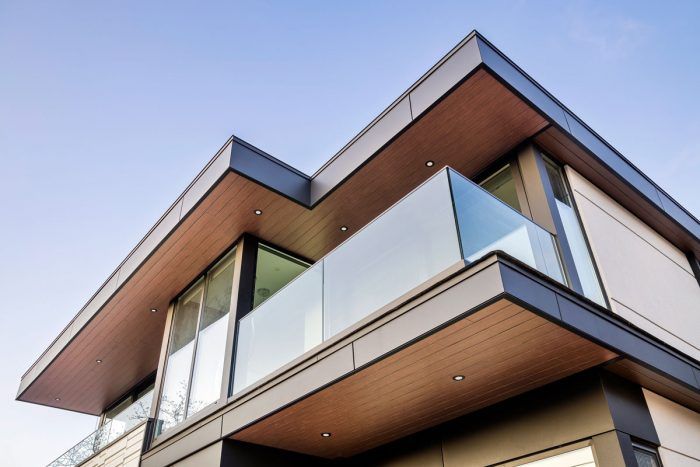More New Products at the Virtual International Builders’ Show
Despite technical issues with the online exhibitors' booths, there were still many new things to discover.

The day began poorly with technical glitches at the conference. However, I was able to sort through a ton of emails announcing new products and events to bring these innovations to your attention. First, I’ll share some new building materials, then some promising tech tools, economic trends, and finally, a house being 3D printed—which is always fun to watch.
Products:
Masonite. The name itself seems the antithesis of innovation. The company has been making embossed, hollow core doors for eons. When these first came out decades ago, they set a trend that put six-panel “Colonist” doors in almost every house built from the 1980s through the early 2000s. It’s with pleasure that I see the company has introduced a plethora of new styles to choose from, including pre-finished painted doors in trending colors.

Aluminum siding: Another product line from a bygone era is aluminum siding. In a back to the future move, Royal introduces Cedar Renditions, a line of photo-realistic wood-like siding made from aluminum. Historically, aluminum siding ran from 16-mils –to– 18-mils thick. Royal increased their Cedar Renditions panels to 27-mil, improving robustness. To wit, the material is rated to 120 psf., which is well over 200 mph in wind resistance.


Composite siding: Introduced by Alside, IBSx chose ASCEND as best in show for Most Innovative Building Material. According to Alside, ASCEND is the world’s first composite cladding engineered with a combination of Glass-Reinforced Polymer and Graphite-Infused Polystyrene. The material boasts a Class A Fire Rating, wind load resistance up to 180 mph, and an insulation value of R-2. It comes in single planks, ¾-inch thick and about seven inches tall.


Innovations:
Several tech novelties caught my eye. As with all the latest high-tech innovations, a great idea is only the start. As with today’s high-glitch event at IBSx, the proof comes with reliable functioning. So, I introduce these apps with a warning, caveat emptor. Buyer beware—great new ideas in technology don’t always work:
3D Capture: If it works as described, Canvas is a miracle for the remodeler. The app will measure a room and create a 3D sketch exportable to several CAD programs, including SketchUp, Revit, AutoCAD, Design 2020 Live, and Chief Architect. Here’s a one-minute video to see how it works. Canvas supports iPhones and iPads with the LiDAR sensor integrated, such as the new iPad Pro, iPhone 12 Pro, and iPhone 12 Pro Max. This app alone would justify an i-Upgrade for me.
I asked, and the prices for the app is by area measured:
- All 3D output formats (SketchUp, Revit, Chief Architect, and 2020 Design Live) will be charged at $0.15 per square foot. ($20/scan minimum)
- 2D Floor Plan output (PDF drawing and AutoCAD-compatible .dwg files) will be set at $0.10 per square foot. ($10/scan minimum)
Canvas is available on iPad under “Canvas: iPad 3D Room Scanner” and iPhone under “Canvas: Pocket Room Scanner.” Online review scores on the App Store 3.4 out of 5. Since some reviewers commented on lack of accuracy, I asked the company, and they responded, “With a LiDAR-enabled device, you should see most measurements within 1-2%, and it’s getting better and better as both the hardware and software improve.”
The new plan room: BidBird®, an e-construction marketplace for professionals to connect through “one-round blind auctions,” taking the work out of the hunt for proposals and securing prices. This platform promises to replace the drudgery of soliciting sub bids. It functions as an online plan room. For those too young, plan rooms were a place subs and material suppliers (and general contractors) could access complete sets of plans and spec to bid on upcoming projects in the local area.
Economic Trends:




Tip: To find labor, appeal to those out of work in the restaurant and hospitality sectors. Use the work satisfaction and wages to entice them to pick up a hammer. While these recruits may not have skills, they likely have the will and financial need to work hard and learn.
Spec-building for rent
Long before the Great Recession, I became an advocate for the construction of single-family rentals. Sometimes townhouse duplexes, too. When the recession came, it was those investments that put food on the table. Today, I am building one for rent and two for sale. So, it did not come as a surprise when the NAHB economics team revealed that “Single-family rents are up 3.5 percent over the last year, while rents on multifamily rental apartments are down 3 percent,” said NAHB Chief Economist Robert Dietz. People prefer to live in a single-family home rather than an apartment. The pandemic only accentuates that demand confirmed the panel of NAHB economists (any my experience).
“My expectation is that the single-family built-for-rent construction market share, which is currently around 4.5 percent, will likely grow to 5-6 percent over the next two to three years,” said Dietz.
Fun with big printers
The emerging use of 3D printers to build homes is always fun to watch. I know of a 3D printed Mexican village and plenty of demonstration projects. Still, I have not seen this technology emerge into a viable competitor to the conventional home builder. However, developers of this equipment keep telling us the day is coming when it will replace us. The promise is economical, solid, and swift. Whole homes printed concrete-strong in 24-hours for a third of the cost of stick-built. For now, it’s simply good fun. Enjoy the video:

Fine Homebuilding Recommended Products
Fine Homebuilding receives a commission for items purchased through links on this site, including Amazon Associates and other affiliate advertising programs.

Original Speed Square

Anchor Bolt Marker

Plate Level

























